| Mangrove is one of the fragile
but highly productive ecosystem found along our Indian coast. Already vast
mangrove areas have been degraded to wastelands as a result of deforestation,
reclamation and pollution. It has also adversely affected the coastal fisheries.
Indian has approximately 700,000
ha of area covered by mangroves along the estuaries and major deltas. There
are vast degraded intertidal wetlands which can be used for various purposes.
These areas can be brought to their pristine glory and high productivity
by taking up large scale mangrove afforestation programmes along the coast.
Mangrove is group of typical
tropical and specialized trees growing in the saline and brackish water
system. The mangrove trees are highly productive and economical which also
protect the shoreline from erosion and cyclonic conditions. In India the
total area covered by mangroves has been estimated to be about 700,000
ha. However these fragile and sensitive trees and their ecosystem have
been abused, neglected and overexploited in India. The major threats to
mangroves are deforestation, reclamation and lately pollution also.
Why
only mangroves
The mangroves are angiosperms,
with 45 species in India. They have special characters like viviparous
germination, pneumatophores, prop or knee roots and salt glands. These
trees form a thick forest belt on the deltas, along major estuaries, and
fringe the estuarine banks, as well as backwaters. This unique tree resources
is used for various purposes like tannin extraction, paper and pulp, firewood,
timber, charcoal, fodder and several other by-products. The mangrove swamps
are rich in the larvae of many economically important fishes, prawns, crabs
and bivalves. These are the most suitable area for feeding, breeding and
nursery grounds of these marine organisms and hence important for aquaculture
purposes.
Why
mangrove afforestation
Indian mangrove have been deforested
and reclaimed to such an extent that the mangroves along the west coast
are very much degraded. This has not only affected the coastline but also
the fisheries to a large extent.
Afforestation of mangrove areas
on a large scale is the most urgent need of today, if the coastal environment
is to be brought back again to its earlier pristine glory.
Where
mangroves grow
Mangrove trees are found growing
luxuriantly in the intertidal regions along the estuaries, backwater, islands
and other protected areas. They generally prefer soft, clay mud for their
growth. These species show different salinity tolerant limits.
The expanse of mangrove forest
depends on the intertidal expanse, substratum and salinity of soil as well
as water. The inundation of the mangrove region during flood or rides is
also one of the important factors.
Which
mangrove species to grow
Out of 45 mangrove species
occurring in India, some are true mangrove while others are considered
as 'associated' flora. The most dominant mangrove species found along the
east and west coast of India are listed below :
Rhizophora mucronata
R. apiculata
Bruguiera gymnorrhiza
B. parviflora
Sonneratia alba
S. caseolaris
Cariops tagal
Heretiera littoralis
Xylocarpus granatum
X. molluscensis
Excoecaria agallocha
Lumnitzera racemosa
Avicennia officinalis
A. marina
There are several other species
which are also useful for different purposes. However, the species mentioned
above are available easily and their seedlings (propagules) or seeds are
also available in considerable quantity in mangrove forest.
How to identify
the species
Species are identified base
on the leaf shape and details of the propagules (Seedlings)
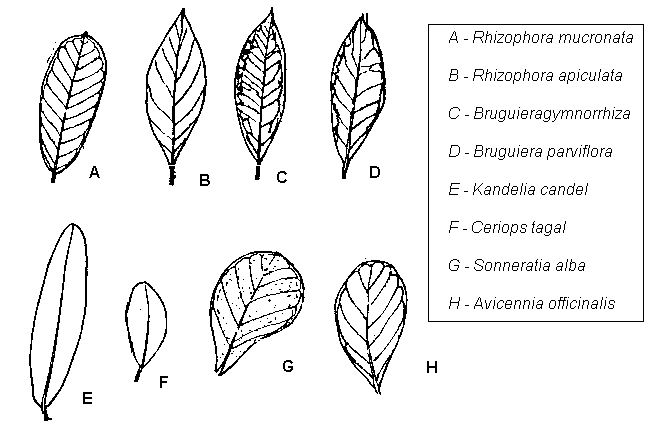
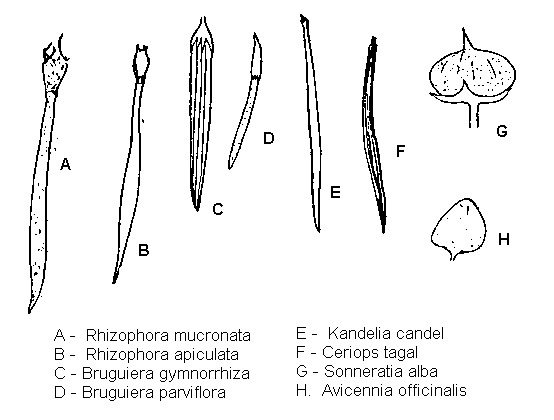 When
seeds and seedlings are to be collected
When
seeds and seedlings are to be collected
Mangrove seeds (fruits and
seedlings) are always available in small quantity throughout the year.
The main fruiting or seedling season, however, start from June to September,
when plenty of seedlings of all the Rhizophoraceae, Avicennia and other
can be collected.
Which
seedlings
Only mature seedlings of these
mangrove species should be collected for afforestation or nursery purpose.
The seedlings of rhizophoracious trees have a podlike structure with tapering
end of varying sizes and with typical morphological characters. Avicennia
fruits are triangular in shape while Sonneratia is globular.
Fruits or seedlings which are
not fully mature or ripe may not grow further resulting into high mortality
rate.
How
to store
Different mangrove porpagules
or seedlings have varying sensitivity for the period of storing.
Species of Rhizophora, Avicennia,
Bruguiera and Ceriops can be stores for 6 - 7 days in brackishwater. However,
seedlings of Kandelia were observed to be very sensitive. Such seedlings
are to be transplanted in the natural swamps or in polyethylene bags in
the nursery immediately, where sufficient moisture or tidal water is available.
Sonneratia fruits can be stored for a longer period.
It is however, always advisable
to store these seedlings partially immersed (pointed end in water) in seawater.
How
to plant
There are two ways of planting
the mangrove seedlings
-
Direct planting in the swamp
-
Raising seedling in the nursery
Direct planting : When seedlings
are collected, check these for any insect borer or other infections and
injuries. Discard such seedlings. Select only healthy, non-infected and
fully matured seedling.
Any intertidal area (between
the high tide and low tide) where mangroves are absent and the substratum
is of soft clay or mud and is inundated by regular tidal waters everyday,
are suitable for direct mangrove planting. Select the sites where intertidal
expanse is more. Along the Gujarat coast and West Bengal, where intertidal
expanse is very large with highest tidal amplitude of 6 to 8 m, the upper
limit of 1 m tidal water level has to be selected.
Planning
Before starting actual planting
it is essential to make a tentative plan of the operation. How much area
is available, which species to be planted and at what position of zonation
pattern.
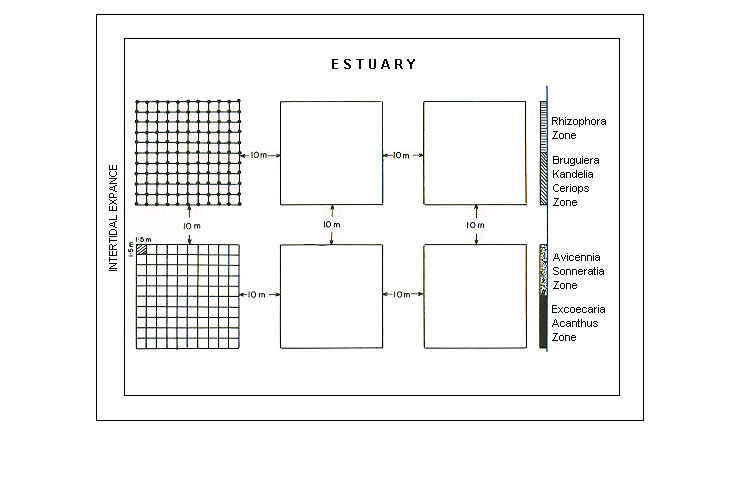
Make suitable plots depending
on the availability of the area. There should be a distance of about 10
m in between two plots. In case of fringing mangroves, where intertidal
expanse is narrow, plot may be parallel to the shoreline. In larger areas
plot may be either rectangular or square with a gap in between two plots.
Planting of different species has also to be decided. Planting of seedlings
may be undertaken according to the length of the propagules. Rhizophora
mucronata or Rhizophora apiculata whose seedlings are the longest should
always be planted towards the waterfront, these can be followed by Kandelia,
Ceriops, Bruguiera, Avicennia, Lumnitzera etc. Species with smallest seeds
like Sonneratia will come to the landward side of the intertidal expanse,
followed by species of grasses and sedges.
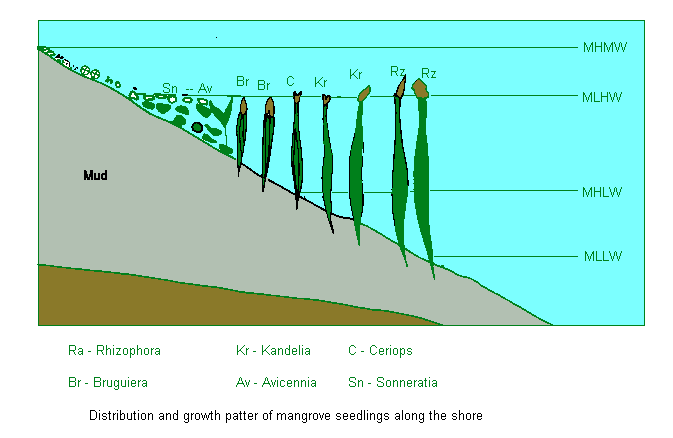
Direct planting method has
to be used in open areas. The selected propagules or seedlings are transported
to the site and planted. Care has to be taken that the pointed end of Rhizophora,
Ceriops, Bruguiera and Kandelia seedlings should always be penetrated into
the mud and the other blunt end, which is a shoot portion, should always
be 6 - 8 inches above the sol level. Avicennia fruits are to be pressed
gently into soil surface.
Nursery
techniques
This method is useful where
the mangrove species are not available in plenty. This also has many advantages,
like selected species are available in large quantities. Mangrove nurseries
can be developed in the upper part of the intertidal region where seedlings
can be grown in polyethylene bags supported with bamboo’s.
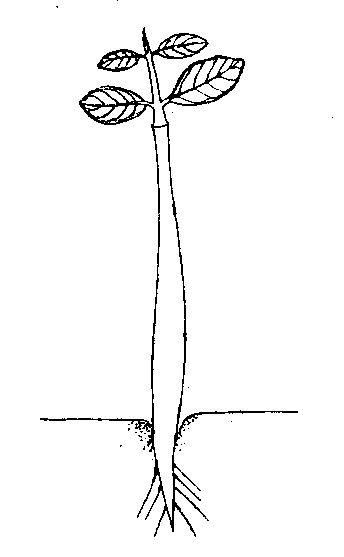
Spacing
between plants
This is another important factor.
Spacing differs according to the purpose for which the plants are grown,
and also depends on the mangrove species grown
However, for the plants suggested
above the spacing between two plants may be about 1.3 m to 1.5 m.
Aftercare
One the plantation is established,
then there is not much to be done. Only these plantations are to be protected
from the grazing cattle, sheep’s and camels Periodical
checking is helpful in finding out whether there is any need to replacement.
But this is very minor.
There is no need of any insecticide,
pesticide, fertilizer, or anything but only protection. Plants will grow
on their own.
|
Species
|
Pest
|
counter
measures
|
| Rhizophora apiculata |
|
Almost free from
pests and diseases |
| Rhizophora alba |
Rats eat seeds.
Rats eat young
shoots and leaves |
Use containers at
germination stage
Cover the nursery
beds with wire net while the seedlings are young and soft |
|
Crabs eat young
shoots and leaves |
Cover the nursery
beds with plastic net while the seedlings are young and soft |
| Avicennia marina |
Rats eat seeds
Crabs eat young
shoots and leaves |
Use container at
germination stage
Cover the nursery
beds with plastic nets while the seedlings are young and soft |
| Ceriops tagal |
|
Almost free from
pests and diseases |
| Xylocarpus granatum |
|
Almost free from
pests and diseases |
Where
to plant
The mangrove nursery may be
located near the estuary or sea where seawater or estuarine water is available.
The nursery may be on the open ground or in the low lying protected areas
where seawater reaches.
The collected and selected
seedlings are inserted in the polyethylene bags (4" X 10" size) filled
with mangrove soil. If the nursery is on the raised ground then the perforations
in the bags are not needed, but the nurseries in the low lying area need
the perforations in the polyethylene bags.
The seedlings thus grown, in
different sizes of plots, anywhere else need watering everyday. However,
the low lying intertidal areas get natural tidal waters twice every day.
These seedlings may be allowed
to grow upto the period of 6 months to 1 year and then depending on the
requirement of species of the region, these can be transferred to the site
in a boat or cart.
The transplantation techniques
may be same as indicated for direct planting. Only care should be taken
to cut open the polythene bags at the base. Spacing may be the same depending
on the purpose.
What
is the survival rate
If due care is taken in selecting
the seedlings used for plantation, then the survival rate is very high
(about 90 to 95%). However, in polluted areas the mortality may be high
because of toxic substances discharged from the industries. Therefore,
it will be advisable to avoid such polluted areas. Sewage pollution or
low level nontoxic pollutants may not have harmful effect on mangrove plants.
On the other hand it has been found that mangrove trees can reduce the
pollution by absorbing certain chemicals. Very high sediment load with
fast current may also some time pose little problem
Any
poisonous plants ?
There are no poisonous plant
in mangroves. However, while handling Excoecaria agallocha care should
be taken not to touch the milky juice to the eyes. This is harmful and
sometimes leads to blindness. |
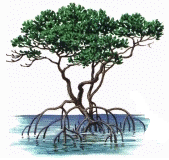 How to Grow Mangroves
How to Grow Mangroves
![]() Why only mangroves
Why only mangroves
![]() Why mangrove afforestation
Why mangrove afforestation
![]() Where
mangrove grows
Where
mangrove grows
![]() Which
mangrove species to grow
Which
mangrove species to grow
![]() How
to identify species
How
to identify species
![]() When
seeds and seedings to be collected
When
seeds and seedings to be collected
![]() Which
seedlings
Which
seedlings
![]() How
to store
How
to store
![]() How
to plant
How
to plant
![]() Planning
Planning
![]() Nursery
techniques
Nursery
techniques
![]() After
care
After
care
![]() Where
to plant
Where
to plant
![]() What
is the survival rate
What
is the survival rate
![]() Any
poisonous plants
Any
poisonous plants